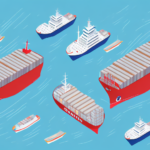Understanding Shipping Terminology: A Comprehensive Guide
If you're involved in any aspect of the shipping industry, it's essential to have a clear understanding of shipping terminology. From cargo types to freight charges, customs regulations to trade terms, mastering the technical jargon and industry-specific language is crucial for effective communication within the sector. This comprehensive guide delves into every aspect of shipping terminology, from the basics to more complex concepts, ensuring you can confidently engage with other professionals in the field. Let’s explore the essential terms and their significance in the shipping industry.
Importance of Shipping Terminology
The shipping industry is laden with specialized language and abbreviations that can be overwhelming, especially for newcomers. A solid grasp of shipping terminology not only facilitates clear communication but also enhances your ability to navigate the industry's complexities. Here are some key reasons why understanding shipping terminology is vital:
- Effective Communication: Enables you to converse confidently with industry professionals, reducing the likelihood of misunderstandings.
- Operational Efficiency: Helps in accurately interpreting shipping documents, thus avoiding delays and errors.
- Negotiation Power: Equips you with the knowledge to negotiate better rates and terms with carriers and service providers.
- Risk Management: Assists in identifying potential issues or discrepancies in shipping documents, mitigating legal and financial risks.
Key Shipping Terms and Definitions
Basic Shipping Terms
Familiarizing yourself with the fundamental terms used in shipping is the first step toward mastering the industry's language. Here are some essential terms:
- Carrier: The company responsible for transporting goods from one location to another.
- Consignee: The individual or company designated to receive the cargo.
- Freight Forwarder: An intermediary that arranges the shipping of goods on behalf of shippers, handling tasks such as documentation and logistics coordination.
- Bill of Lading: A legally binding document that outlines the details of a shipment, including the type of goods, origin, destination, and terms of carriage.
Abbreviations and Acronyms
The shipping industry frequently employs abbreviations and acronyms to streamline communication. Understanding these is crucial:
- FCL (Full Container Load): A shipment that occupies the entire container, providing cost-efficiency for bulk goods.
- LCL (Less-than-Container Load): A shipment that does not fill an entire container, typically involving shared containers with other shipments.
- ETA (Estimated Time of Arrival): The projected time when a vessel is expected to reach its destination.
- ETD (Estimated Time of Departure): The projected time when a vessel is expected to depart from its origin.
Note that some abbreviations, such as LCL, might vary regionally. For instance, in North America, LCL is often referred to as Less-than-Container Load (LCL).
Types of Cargo
Different types of cargo require specific handling, documentation, and shipping terms. Understanding these categories is essential for efficient cargo management:
- Bulk Cargo: Unpackaged goods transported in large quantities, such as coal, grain, or ore.
- Breakbulk Cargo: Individually loaded and transported items like machinery, vehicles, or crates.
- Containerized Cargo: Goods transported in standardized containers, facilitating easier loading and unloading.
- Liquid Cargo: Includes oils, chemicals, and liquefied natural gas, typically transported in specialized tankers.
- Project Cargo: Oversized, heavy, or complex items requiring special handling, such as wind turbines or large construction equipment.
Freight Charges and Fees
Understanding the various freight charges and fees is crucial for budgeting and cost management in shipping. Here are the primary types of charges you may encounter:
- Freight Charges: The base cost charged by the carrier for transporting cargo from the origin to the destination.
- Demurrage Charges: Fees imposed when cargo remains at the port beyond the agreed-upon free time, indicating delays in pickup or unloading.
- Terminal Handling Charges: Fees for the handling of containers at the port terminals, including loading and unloading.
- Fuel Surcharge: An additional fee to cover fluctuating fuel costs, typically calculated as a percentage of the base freight charges.
- Customs Clearance Fees: Charges for processing goods through customs, including documentation and compliance checks.
- Insurance: Optional coverage to protect against potential losses or damages during transit.
For a detailed breakdown of freight charges, refer to the Investopedia guide on freight charges.
Customs and Trade Regulations
International shipping involves navigating a complex web of customs and trade regulations. Understanding the key terms and compliance requirements is essential to ensure smooth transit of goods:
- Customs Broker: A licensed professional who facilitates the clearance of goods through customs on behalf of importers and exporters.
- Incoterms: International commercial terms that define the responsibilities of buyers and sellers in global transactions, including the division of costs and risks.
- Harmonized System Code (HS Code): A standardized numerical method of classifying traded products, crucial for determining duties and taxes.
- Import/Export Licenses: Authorization documents required for shipping certain goods, depending on the country and product type.
Staying informed about the latest customs regulations can prevent delays and ensure compliance. The World Trade Organization (WTO) provides valuable resources on international trade regulations.
Documentation in Shipping
Bill of Lading
The Bill of Lading is one of the most critical documents in the shipping process. It serves three primary functions:
- Receipt of Goods: Confirms that the carrier has received the cargo as described.
- Title Document: Represents ownership of the goods, facilitating the transfer of ownership during transit.
- Contract of Carriage: Outlines the terms and conditions under which the goods are transported.
Properly managing the Bill of Lading is essential to avoid legal disputes and ensure the rightful delivery of goods. For more information, refer to the BLF Registry's guide on Bills of Lading.
Other Essential Documents
- Commercial Invoice: Details the transaction between the seller and buyer, including prices, quantities, and terms of sale.
- Packing List: Provides information about the contents, packaging, and handling instructions for the shipment.
- Certificate of Origin: Verifies the country where the goods were manufactured, which can affect tariffs and trade agreements.
- Insurance Certificate: Confirms that insurance coverage is in place for the shipment.
Container Terminology
Understanding container sizes, types, and dimensions is fundamental for efficient cargo handling and transportation. Here are key terms related to shipping containers:
- TEU (Twenty-foot Equivalent Unit): A standard measure used to describe the capacity of container ships and terminals, representing one 20-foot container.
- High Cube: A container type that is taller than standard, typically offering an additional foot in height for transporting bulkier items.
- Reefer Container: A refrigerated container designed to transport perishable goods, maintaining specific temperature controls.
- Open Top Container: A container without a fixed roof, allowing for the loading of oversized cargo from the top.
- Flat Rack Container: A container with collapsible sides, ideal for oversized or irregularly shaped cargo.
For a comprehensive overview of container types, visit the Container Container resource.
Incoterms: International Trade Terms
Incoterms are a set of predefined commercial terms published by the International Chamber of Commerce (ICC) that are widely used in international transactions. They define the responsibilities of buyers and sellers regarding the delivery of goods, allocation of costs, and risk transfer. Understanding Incoterms is crucial for negotiating contracts and ensuring clear agreements between trading partners. Some common Incoterms include:
- EXW (Ex Works): The seller makes the goods available at their premises, and the buyer assumes all costs and risks from that point onward.
- FOB (Free On Board): The seller is responsible for delivering the goods on board the vessel, with the buyer assuming risk and costs once the goods are on board.
- CIF (Cost, Insurance, and Freight): The seller covers the cost, insurance, and freight to bring the goods to the destination port, while the buyer assumes risk once the goods are on board.
For detailed information on each Incoterm, refer to the ICC's official Incoterms guide.
Common Challenges and Tips for Mastering Shipping Terminology
Despite its importance, mastering shipping terminology can be challenging due to the industry's complexity and the continuous evolution of terms. Here are some common challenges and tips to overcome them:
Challenges
- Language Barriers: Working with international partners can introduce language differences, making terminology comprehension difficult.
- Regional Variations: Terms and abbreviations may vary by region, leading to confusion and miscommunication.
- Volume of Terms: The sheer number of specialized terms can be overwhelming for newcomers.
Tips for Mastery
- Invest in Education: Take courses or attend workshops focused on shipping and logistics to build a strong foundational knowledge.
- Utilize Online Resources: Leverage online glossaries, industry publications, and reputable websites to stay updated on terminology.
- Network with Professionals: Engage with industry experts through forums, social media, or professional associations to gain insights and practical understanding.
- Practical Application: Apply the terms in real-world scenarios, such as reviewing shipping documents or participating in logistics planning, to reinforce your learning.
Future Trends in Shipping Terminology
The shipping industry is continuously evolving, and new trends are shaping the future of shipping terminology. Anticipating these changes can keep you ahead in the field:
- Technological Advancements: Innovations like blockchain, artificial intelligence, and the Internet of Things (IoT) are introducing new terms and changing existing ones. For example, blockchain technology is streamlining documentation processes, leading to terms like smart contracts becoming more prevalent.
- Sustainability Focus: With increasing emphasis on environmental responsibility, terms related to green shipping practices, such as carbon-neutral shipping and sustainable logistics, are gaining traction.
- Automation and Robotics: The rise of automation in ports and logistics is introducing terminology related to automated guided vehicles (AGVs) and robotic handling systems.
- Cybersecurity: As digitalization increases, so does the need for terms related to cybersecurity measures in shipping operations.
Staying informed about these trends through sources like the Maritime Executive can help you adapt to the evolving language of the shipping industry.
Conclusion
In the dynamic world of shipping, a comprehensive understanding of shipping terminology is indispensable. From basic terms to complex concepts, mastering the specialized language of the industry enhances communication, operational efficiency, and strategic decision-making. By familiarizing yourself with key terms, leveraging reputable resources, and staying abreast of industry trends, you can confidently navigate the complexities of the shipping sector and contribute effectively to your organization's success.






















